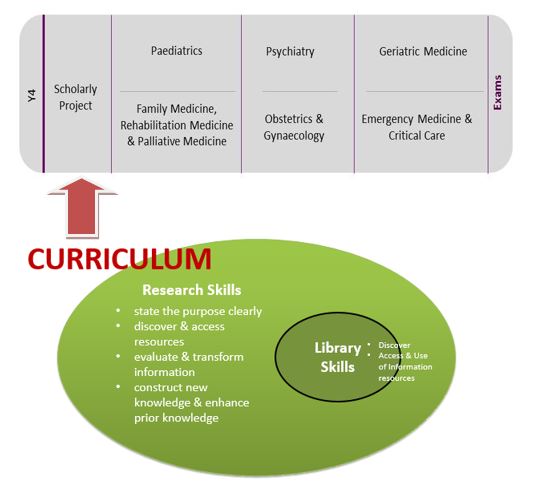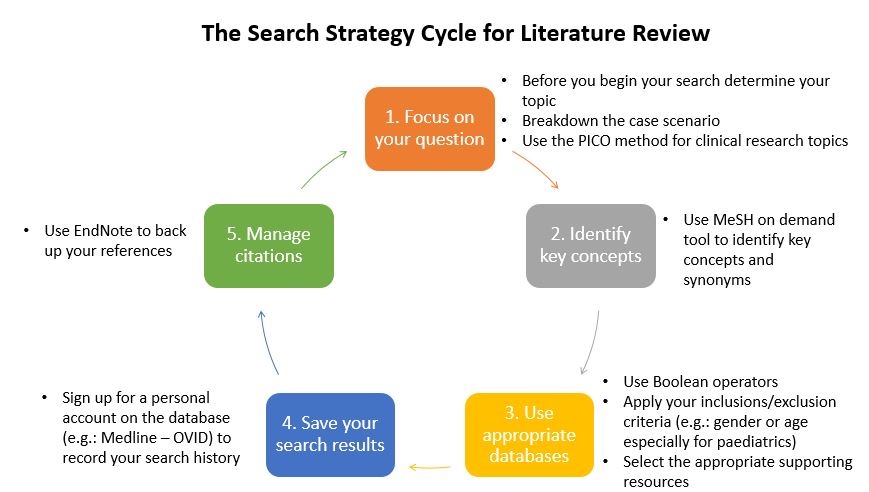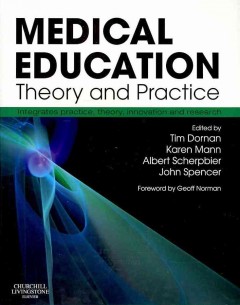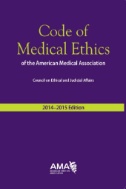INTRODUCTION
Now that you have made it to Year 4, you will embark on scholarly projects for 6 weeks. The key element for Year 4 students is to perform independent search, independent writing skills and advanced citation skills at the end of their course of study. Year 4 students will experience these skills during their course of study through a variety of TBL exercises (group learning), self-directed learning and attending optional information literacy organised for you. See figure 1.
Fig 1: Year 4 Key Elements, Research & Library Skills, Medical Library ©
Global Information Literacy Standards
Information Literacy is important throughout the world and many interesting programs are being developed. Here are a few links on information literacy standards and definitions.
-
ACRL – Information Literacy Competency Standards for Higher Education
-
The SCONUL Seven Pillars of Information Literacy for Higher Education: Core Model
-
IFLA: International Federation of Library Associations Information Literacy Section
Students are encouraged to engage their medical librarians if they require further guidance or wish to have training. Simply, drop us an e-mail at medlib@ntu.edu.sg or contact us at 6592 1990.
ACTIVITY 1: Let us know your research needs better
Complete this survey questionnaire developed for Year 4 students. Your feedback will help us evaluate and understand your research needs.
RESOURCES TO GET YOU STARTED!
- Medical Library Survival Guide (Here is a list of ten tips to get you started and going!)
- Research information evaluation tools: radar-test checklist and AACODS Technique (See below Student Consultation Session page)
- Grey Literature sources(See below Student Consultation Session page)
- Click here for a PDF version of this page
INTEGRATING LIBRARY & RESEARCH SKILLS WITH MBBS CURRICULUM
Your medical library guides you to acquire basic information literacy and writing skills using examples of case scenarios/ research topics from your Year 4 textbooks and reliable research materials (Refer to Year 4 e-books from our Pinterest webpage).
Year 4: Medicine for All Stages of Life & in Diverse Settings
Fig 2: Curriculum integration with research and library skills (Adapted from: LKC Medicine Curriculum MBBS, Year 4)
SEARCH STRATEGY CYCLE FOR AN EFFECTIVE LITERATURE REVIEW
Here’s the search strategy cycle you need to refer to when performing a literature review for your research question/ case scenarios. See Fig 3 for more information.
Fig 3: Search Strategy Cycle for Literature Review, Medical Library ©
There are accompanying descriptors for students to understand each stage better. Refer to activities 2, 3 and 4. Activities consist of research questions on:
-
Paediatric Medicine –Specialization: Paediatric Respiratory Medicine
-
Obstetrics & Gynaecology (OBGYN) Medicine – Specialization: General OBGYN
Questions posed in each activity are accompanied with librarian tips for students to experience independent search skills, advanced writing skills and advanced citation management skills from these activities.
TEST YOUR SEARCH SKILLS. GIVE THESE EXERCISES A TRY!
Activity 2: Respiratory Distress in Neonates (Paediatric Respiratory Medicine)
Chelsea, a 3-month old baby girl, is referred to paediatrics with a 2-day history of feeding difficulties and a cough. On examination, she has a runny nose and looks dehydrated. Furthermore, she has signs of respiratory distress, with a widespread expiratory wheeze; SaO2 (on air) 90%. Chelsea's mum tells you her baby is not taking her bottle and her nappy are much drier than normal. (Source: Comprehensive core clinical cases: self-assessment for medical students - Andrew Sewart, Henriette van Ruiteng. Publication: 2012).
Develop the following components:
- Six signs for respiratory distress in an infant
- Normal heart rate and respiratory rate in infants
- Four signs of dehydration in infants
- Calculation of maintenance fluid requirement for Chelsea who is 5.8kg
- References (*Note: Please use Vancouver style)
(a) Use the PICOS method to formulate clinical questions. (Refer to EBM step 1 for standard template and other related information)
- Librarian tips for part (b):
Watch these short EBM videos conducted by Professor Paul Glasziou and Dr Rafael Perera from the University of Oxford’s Centre for Evidence-Based Medicine (CEBM).
EBM video 1: Formation of PICO, PO and PO questions.
Source: [Evidence-Based-Education]. (2009, September 22). Evidence-Based Medicine in Practice – Appraisal of Clinical Trials #1. [Video File]. Retrieved from https://www.youtube.com/watch?v=QsIYwWwi_r4.
EBM video 2: Feasibility of introducing evidence-based techniques into normal medical practice.
Source: [Evidence-Based-Education]. (2009, September 17). Evidence-Based Medicine in Practice – Appraisal of Clinical Trials #2. [Video File]. Retrieved from https://www.youtube.com/watch?v=xLS1ng6D32Y&t=16s
EBM video 3: This short excerpt features Dr Rafael Perera from the University of Oxford’s Centre for Evidence-Based Medicine (CEBM) introducing the topic of clinical trial appraisal by way of an example from the course workbook.
Source: [Evidence-Based-Education]. (2009, September 17). Evidence-Based Medicine in Practice – Appraisal of Clinical Trials #1. [Video File]. Retrieved from https://www.youtube.com/watch?v=QsIYwWwi_r4
- You need to formulate well-built questions using the PICOS method
- For example: P = Infant: Female, Age: < 1 year. History – Symptoms: Feeding difficulties, cough, wheeze,runny nose, associated symptoms of Dyspnea and severe exacerbation with SaO2 in room air less than 92% oxygen supplementation. Signs of dehydration.
- Continue to complete the rest of the PICO
- Your clinical questions are mapped according to? (Select the ones that apply)
- etiology/risk
- clinical manifestations of disease
- differential diagnosis
- prognosis
- therapy
- prevention
- experience and meaning
- improvement
- Select the type of study: How well a study limits potential bias is tied to its validity, and determines where it falls within a hierarchy of evidence.
- Refer to the Resources for Evidence-Based Practice: The 6S Pyramid from McMaster University, Health Sciences
- Meta-Analysis
- Systematic Review
- Randomized Controlled Trial
- Cohort Study
- Case Control Study
- Case series or Case Report
- Animal Research
- In Vitro/Lab Research
- Editorials, Letters, Opinions
- Watch this video conducted by Dr. Mohit Bhandari from ORTHO EVIDENCE explain in greater detail about the Hierarchy of Evidence in Medicine
- Refer to the Resources for Evidence-Based Practice: The 6S Pyramid from McMaster University, Health Sciences
Video 4: Hierarchy of Evidence
https://www.youtube.com/watch?v=LG-uJmV-l7w&t=508s
Source: [Lakshmisree T]. (2012, December 6). Hierarchy of Evidence. [Video File]. Retrieved from https://www.youtube.com/watch?v=LG-uJmV-l7w&t=508s
Quotes from Dr Bhandari’s video:
“Hierarchy of Evidence provides a guide towards categorizing clinical research. Studies that limit bias to the greatest extent are higher levels of evidence…A poor quality study gets you down graded to a level. Less than 80% follow up downgrades a level 1 to a level 2”
- What are the search terms and alternative terms identified for your PICO question?
- State your inclusion and exclusion criteria
- Example: gender, age, year of publication
- What are the irrelevant terms you want to exclude in your search?
- What medical databases do you want to use to plan your search?
- Example: Medline – OVID, PubMed etc.
- TRIP Database for PICO
Additional help:
As for the PICO principle, here are recommended sites from top medical schools in the world
- PICO examples from University of Oxford
- EBM – Evidence Based Medicine from Harvard University
- Explanation of the 2011 OCEBM Levels of Evidence
(b) What are the MeSH terms identified for this topic?
Librarian tips for part (b):
- Refer to your PICO answers before performing MeSH search
- Review top 10 relevant articles identified from PubMed
(c) How did you conduct your search using suitable medical databases (e.g: PubMed, Clinical Key and Web of Science)?
Librarian tips for part (c):
PubMed
- Click Advanced Search Builder to view the video tutorial
- Click PubMed Simple Subject Search: How It Works to view the video tutorial
- Click Retrieving Citations from a Journal Issue to view the video tutorial
Clinical Key
- Click Clinical Key user guide
Web of Science
- Click Search Tips
- Click Advanced Search
- Click Refine & Analyze Search Results
- Click How to do a Cited Reference Search?
- Click Journal Citation Reports: Impact Factor
- Click Exporting records
What’s new in Web of Science?
Source: [Web of Science Training]. (2017, June 25).What’s New in Web of Science – June 2017. [Video File]. Retrieved from https://www.youtube.com/watch?v=_ZTqA-ASAls&t=20s
Search for systematic reviews using:
- Librarian tips:
Watch these videos from OvidWoltersKluwer on systematic reviews in EBHC.
Video 5: The Role of Systematic Reviews in Evidence-Based Healthcare (EBHC)
Source: [OvidWoltersKluwer]. (2015, October 6). The Role of Systematic Reviews in Evidence-Based Healthcare. [Video File]. Retrieved from https://www.youtube.com/watch?v=vhitDGfO8qU
Video 6: Step 1 in a Systematic Review
Source: [OvidWoltersKluwer]. (2015, October 6). Step 1 in a Systematic Review. [Video File]. Retrieved from https://www.youtube.com/watch?v=lfO5yB9EoJU
Video 7: Step 2 in a Systematic Review
Source: [OvidWoltersKluwer]. (2015, October 6). Step 2 in a Systematic Review. [Video File]. Retrieved from https://www.youtube.com/watch?v=Ky4bU94dZnY
Video 8: Step 3 in a Systematic Review
Source: [OvidWoltersKluwer]. (2015, October 6). Step 3 in a Systematic Review. [Video File]. Retrieved from https://www.youtube.com/watch?v=MEBal2QgH7c
When using databases to search for systematic reviews:
(1) Medline – OVID (EBM Reviews – Cochrane Database of Systematic Reviews 2005 to November 23, 2016)
- For example: Type the search sentence – respiratory distress in neonates
- Select the systematic review title: Positive end expiratory pressure for preterm infants requiring conventional mechanical ventilation for respiratory distress syndrome or bronchopulmonary dysplasia.
- Read and review
(2) Cochrane Library and Cochrane Clinical Answers
- Watch Online self-paced tutorials on how to use Cochrane Library
- See ppt slides on how to use Cochrane Clinical Answers
(d) How many relevant articles did you retrieve? How do you report the use of systematic reviews?
Librarian tips for part (d):
- This is where you search for evidence
- Review Resources for Evidence-Based Practice: The 6S Pyramid (Source: McMaster University Health Sciences). Use the 6S Pyramid and map your search results from selected databases
- When reporting the use of systematic reviews, the PRISMA flow diagram needs to be completed. Use the PRISMA checklist as a reference.
(e) How do you evaluate the quality of your article search?
Librarian tips for part (e):
- Use the radar-test checklist to evaluate the quality of the articles obtained from your search.
- Locate at least 2 grey literature source (e.g.: MOH – Management of Asthma and RSV in infants). Use the AACODS technique to evaluate information.
- Refer to the Student Consultation Sessions How do you search for Grey Literature?
- Refer to the Student Consultation Sessions page for Evaluations tools for Grey Literature
- When using Web of Science, you need to analyse the journal impact factor and cited times. For example:
- Revisit the article, ‘‘Left ventricular non-compaction in children and adolescents: Clinical features, treatment and follow-up’
- Change to ‘Times Cited – Highest to lowest’
- Show them the times cited section and Analyse results
- Select Web of Science Categories
- Perform a combined search and view records
- View the journal impact factor (bottom of the page) and view the year
- Use these critical appraisal worksheets for systematic reviews from:
Watch these EBP videos from Assoc Professor Terry Shaneyfelt from UAD, School of Medicine on how to perform a critical appraisal on systematic reviews
Video 9: How to Critically Appraise a Systematic Review: Part 1
Source: [Terry Shaneyfelt]. (2013, March 5). How to Critically Appraise a Systematic Review: Part 1. [Video File]. Retrieved from https://www.youtube.com/watch?v=NSUk5FLbJoY
Video 10: How to Critically Appraise a Systematic Review: Part 2
Source: [Terry Shaneyfelt]. (2013, March 6). How to Critically Appraise a Systematic Review: Part 2. [Video File]. Retrieved from https://www.youtube.com/watch?v=Ly__U-n4fiQ
(f) How do you write your answer using at least 5-7 selected articles? (Hint: Limit answer to less than 1000 words)
Librarian tips for part (f):
- Keep your interpretation of result simple, clear and factual to clinical findings.
- Spend some time reading materials about paraphrasing and plagiarizing from top 3 medical schools in the world
- Harvard University – ‘What constitutes plagiarism?’
- University of Oxford – Plagiarism
- University of Cambridge – Avoiding plagiarism and falsification
Additionally a good read from Imperial College London – Plagiarism awareness.
BONUS CLIP! Avoiding Plagiarism: Writing With Integrity
Watch this video by Dr Candace Hastings from Texas A&M University on how to avoid plagiarism
Source: [tamuwritingcenter]. (2015, Feb 28). Avoiding Plagiarism: Writing With Integrity. [Video File]. Retrieved from https://www.youtube.com/watch?v=F1S1FZ-bn5E
Here are some recommended books to approach your writing skills for this question
- Sewart A. Comprehensive core clinical cases : self-assessment for medical students. Knutsford : Pastest Ltd, 2012
- Soh S, Jamuar S, Puthucheary J. The baby bear book : a practical guide on paediatrics. Singapore : Red Cells Series, 2015
- Stern S, Cifu A, Altkorn D. Symptom to diagnosis : an evidence-based guide. New York] : McGraw-Hill Medical, 2015
- Harris W. Examination paediatrics : a guide to paediatric training. Chatswood, N.S.W. : Elsevier, 2011
Any other good writing tips?
- Barnard and Deborah St James are co-authors of Listen. Write. Present.: The Elements for Communicating Science and Technology (Yale University Press; 2012). (Source http://www.medicalpracticeinsider.com/news/4-questions-will-help-hone-your-writing-skills)
- Top 10 good attributes of a good medical writer by SIRO
(g) Use EndNote and list the citations used to answer part (f) in Vancouver style.
Librarian tips for part (g):
- View EndNote for (Mac)
- Use EndNote (Windows) in 7 minutes
Take your learning one step further!
ACTIVITY 3: Diagnosed with Bronchiolitis (Continued case study from Activity 2)
You diagnose Chelsea with Bronchiolitis and admit her to the ward where she is barrier-nursed to prevent spread.
Develop the following components:
- Four clinical features of bronchiolitis
- Five types of patients at risk of bronchiolitis
- Common cause of bronchiolitis and how it is detected
- Managing Chelsea’s clinical condition of bronchiolitis
- Identify the prophylactic antibody for RSV
- Monitoring the effectiveness of treatment
(a) For components 1 to 3, conduct the typical information search using suitable medical databases
Librarian tips for part (a):
- Refer to part (c) in activity 2
(b) For component 4, refer to clinical guideline practices in local hospitals
Librarian tips for part (b):
- Refer to Soh S, Jamuar S, Puthucheary J. The baby bear book : a practical guide on paediatrics. Singapore : Red Cells Series, 2015
- You can also refer to Clinical Practice Guidelines on the Internet
(c) For component 5, you can use Micromedex or Martindale (drug databases) to identify drug name to treat patient
Librarian tips for part (c):
- Type RSV and select the best choice from drop-down options
- Select answer
- Read and understand treatment administered for patient < 1 year of age
You can search using Google Scholar to read more about the identified prophylactic antibody to reduce severity of complications of RSV for neonates.
- Ask yourself, ‘Does it prevent infection?’
(d) Monitoring the effectiveness of treatment
Librarian tips for part (d):
- You can approach the question by searching for information on discharge criteria for bronchiolitis
- Refer back to answers from part (a) exercise 1
ACTIVITY 4: ‘VTE prophylaxis in pregnancy'(OBGYN MEDICINE: Short Case)
Read the following adapted text from Chapter 6: Labour and Delivery, Caesarean section: Complications – Postoperative complications. (Adapted from: Collins, S, & Arulkumaran, S 2013, Oxford Handbook Of Obstetrics And Gynaecology. [Electronic Resource], n.p.: Oxford ; New York : Oxford University Press, 2013)
Postoperative complications occur in up to 1/3 of women and include:
- Endometrics (5%)
- Wound Infections (3-27%)
- Pulmonary atelectasis
- Venous thromboembolism (VTE)
- Urinary Tract Infections
Risk factors independently associated with infection are:
- Preoperative remote infection
- Chorioamnionitis
- Maternal severe systemic disease
- Pre-eclampsia
- High BMI
- Nulliparity
- Increase surgical blood loss
(1) Discuss the route/timing/dose of heparin if it should be given preoperatively or start 4 hours postoperatively for patient at high risk of developing VTE. Patient did not receive heparin at prenatal stage and requires an emergency cesarean section. (Adapted from: Heparin at caesarean section (query bank). (2016). Royal College of Obstetricians & Gynaecologists).
(2) Perform a Cochrane review.
(a) Use the PICO method to formulate clinical questions
Librarian tips for part (a):
- Refer to page on Evidence Based Medicine > Step 1
(b) What are the MeSH terms identified for this topic?
Librarian tips for part (b):
- Refer to your PICO answers before performing MeSH search
- Review top 10 relevant articles identified from PubMed
(c) How did you conduct a systematic review search using suitable medical databases (e.g.: Medline – Ovid, Cochrane Library & Cochrane Clinical Answers)?
Librarian tips for part (c):
Use:
- Medline – OVID (EBM Reviews – Cochrane Database of Systematic Reviews 2005 to November 23, 2016)
- For example: Type the search sentence – VTE prophylaxis in pregnancy AND heparin
- Select the systematic review title: Prophylaxis for venous thromboembolic disease in pregnancy and the early postnatal period.
- Read and review
- Cochrane Library and Cochrane Clinical Answers
- Refer to the EBP videos on systematic reviews shown in Exercise 2
When evaluating systematic reviews:
Use these critical appraisal worksheets to evaluate the quality of systematic reviews from:
- Oxford Centre for EBM
- Centre for Health Evidence University of Alberta &
- Centre for Evidence-Based Medicine: Mount Sinai Hospital, University of Toronto
Complete the PRISMA flow diagram
Review Resources for Evidence-Based Practice: The 6S Pyramid (Source: McMaster University Health Sciences)
(d) How many relevant articles did you retrieve? How do you evaluate them?
Librarian tips for part (d):
- You can view relevant articles from the MeSH browser (part a)
- Use the radar-test checklist to evaluate the quality of the articles obtained from your search.
- Locate at least 2 grey literature source. Use the AACODS technique to evaluate information.
- Refer to the Student Consultation Sessions page for Evaluations tools for Grey Literature
(e) How do you write your answer using at least 5-7 selected articles? (Hint: Limit answer to less than 1000 words)
Librarian tips for part (e):
Spend some time reading materials about paraphrasing and plagiarizing from top 3 medical schools in the world
- Harvard University – ‘What constitutes plagiarism?’
- University of Oxford – Plagiarism
- University of Cambridge – Avoiding plagiarism and falsification
Additionally a good read from Imperial College London – Plagiarism awareness.
Further reading materials for successful writing skills:
- Kallestinova, E. D. (2011). How to Write Your First Research Paper. The Yale Journal of Biology and Medicine, 84(3), 181–190.
- Bredan, A. (2013). Inheritance of poor writing habits: To improve scientific writing we must break the chain of transmission of complex writing style from senior to junior scientists.EMBO Reports, 14(7), 593–596. http://doi.org/10.1038/embor.2013.76
- Gattrell, W. T., Hopewell, S., Young, K., Farrow, P., White, R., Wager, E., & Winchester, C. C. (2016). Professional medical writing support and the quality of randomised controlled trial reporting: a cross-sectional study.BMJ Open, 6(2), e010329. http://doi.org/10.1136/bmjopen-2015-010329
- Clabough, E. B. D., & Clabough, S. W. (2016). Using Rubrics as a Scientific Writing Instructional Method in Early Stage Undergraduate Neuroscience Study.Journal of Undergraduate Neuroscience Education, 15(1), A85–A93.
- Stone, E. M. (2014). Guiding Students to Develop an Understanding of Scientific Inquiry: A Science Skills Approach to Instruction and Assessment.CBE Life Sciences Education, 13(1), 90–101. http://doi.org/10.1187/cbe-12-11-0198
You can access these materials from PubMed from our NTU database
(f) Use EndNote and list the citations used to answer part (g) in Vancouver style.
- View EndNote for (Mac) & (Windows)
- Use EndNote (Windows) in 7 minutes
BONUS CLIP! HOW DO YOU WRITE A GREAT RESEARCH PAPER?
Watch this video by Dr Simon Peyton Jones from University of Cambridge on how to write a great research paper (7 simple suggestions)
https://www.youtube.com/watch?v=g3dkRsTqdDA
Source: [S. R. S Iyengar]. (2013, May 18). How to Write a Great Research Paper. [Video File]. Retrieved from https://www.youtube.com/watch?v=g3dkRsTqdDA
BONUS CLIP! How do you calculate highly cited journals?
Watch this video on Journal Impact Factor metric – learn how it’s calculated, and how it’s used.
Source: [Web of Science Training]. (2017, June 23). Journal Citation Reports – Journal Impact Factor. [Video File]. Retrieved from https://www.youtube.com/watch?v=ulidYM0ap_A&feature=push-u&attr_tag=xvTpvjYkKUYNP42M-6
HIGHLY RECOMMENDED BOOKS IN NTU LIBRARY
Evidence-based practice across the health professions / Tammy Hoffmann, Sally Bennett, Chris Del Mar. Publication Date: 2013
Medical education : theory and practice / edited by Timothy Dornan … [et al.] ; foreword by Geoff Norman. Publication Date: 2011
The black book of clinical examination / Tey Hong Liang, Erle Chuen-Hian Lim, Jimmy W.K. Lim. Publication Date: 2009
Code of Medical Ethics of the American Medical Association : Current Opinions with Annotations. [electronic resource]. Publication Date: 2015
Educational research : planning, conducting and evaluating quantitative and qualitative research / John W. Creswell. Publication date: 2014
SG DOCTORS COLLECTION
For Paediatric Medicine
- The baby bear book : a practical guide on paediatrics / editors, Shui Yen Soh, Saumya Jamuar, Janil Puthucheary. Publication date: 2015
For Obstetrics and Gynecology (OBGYN) Medicine
- Practical Obstetrics and Gynaecology Handbook for O&G Clinicians and General Practitioners (2nd Edition). Publication date: 2014
Prepared by: Rebecca David (Senior Assistant Manager, Medical Library)







You must be logged in to post a comment.